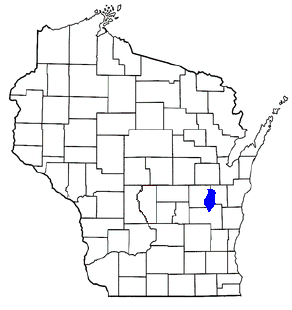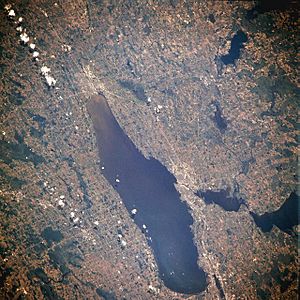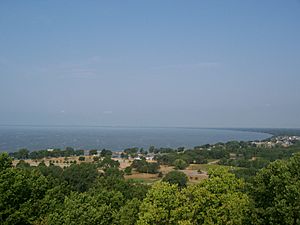Lake Winnebago facts for kids
Quick facts for kids Lake Winnebago |
|
|---|---|

2006 image from space
|
|
| Location | Winnebago, Calumet, and Fond du Lac counties, Wisconsin |
| Coordinates | 44°00′45″N 88°25′03″W / 44.01250°N 88.41750°W |
| Primary inflows | Wolf River, Fox River |
| Primary outflows | Fox River |
| Basin countries | United States |
| Max. length | 30 miles (50 km) |
| Max. width | 10 miles (15 km) |
| Surface area | 131,939 acres (206.155 sq mi; 533.94 km2) |
| Average depth | 15.5 ft (4.7 m) |
| Max. depth | 21 ft (6.4 m) |
| Surface elevation | about 746 feet (227 m) above sea level |
| Settlements | Oshkosh, Fond du Lac, Neenah and Menasha |
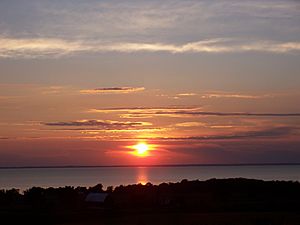
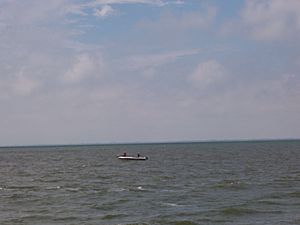
Lake Winnebago is a large, shallow freshwater lake in east central Wisconsin, United States. It is the biggest lake completely within Wisconsin. The lake is about 30 miles (48 km) long and 10 miles (16 km) wide. It has 88 miles (142 km) of shoreline.
The lake is not very deep, with an average depth of 15.5 feet (4.7 m) and a maximum depth of 21 feet (6.4 m). The west side of the lake has many shallow areas, while the east side has a steeper drop-off. There are also several islands along the west shore.
Two main rivers flow into Lake Winnebago: the Wolf River and the Fox River. These rivers meet at Lake Butte des Morts. The Fox River then flows through Oshkosh and into Lake Winnebago. It flows out of the lake near Doty Island in Neenah and Menasha. From there, the Fox River continues northeast and empties into Green Bay. This river is part of the Fox–Wisconsin Waterway. Lake Winnebago is also part of a group of lakes called the Winnebago Pool.
Many cities are located on the shores of Lake Winnebago. These include Oshkosh, Neenah, Menasha, and Fond du Lac. Over 250,000 people get their drinking water directly from the lake.
Contents
Lake Winnebago's Past

About 12,000 years ago, Lake Winnebago was part of a much larger ancient lake called Glacial Lake Oshkosh. This happened when ice blocked water from flowing into Lake Michigan.
The Niagara Escarpment is a ridge of strong rock located a few miles east of Lake Winnebago. Over time, softer rocks under the lake wore away. The harder rocks of the escarpment formed the basin that holds the lake today.
In 1634, French explorers met the Winnebago tribe living near Green Bay and Lake Winnebago. The tribe calls themselves "Ho-Chunk". However, their neighbors called them "Winnebago," which means "people of the stinking water." This name came from the strong fish smell that Lake Winnebago sometimes had in the summer.
In the 1880s, a steamboat called the B. F. Carter traveled across the lake every two weeks in the summer.
Lake Winnebago is also known for something called ice shoves. These happen on very windy days in March when the winter ice breaks up. Residents say it "sounds like a freight train." These ice shoves can be as high as 25 feet (7.6 m) and can damage buildings along the shore.
How Locks and Dams Control the Lake
Lake Winnebago is a natural lake, but its water level was raised by about three feet (0.9 m). This happened when two dams were built in 1850 and 1930. These dams are on either side of Doty Island.
Today, the U.S. Army Corps of Engineers manages the lake's water level. They do this for several reasons:
- To control floods.
- To reduce damage from ice to buildings.
- To release water for power plants and to clean up pollution downstream.
- To keep the water high enough for boating for a longer time.
A system of seventeen locks connects Lake Winnebago to Lake Michigan at Green Bay. This system helps boats travel between the lake and Green Bay, even though there is a height difference of about 150 feet (46 m). The locks are along the lower Fox River, starting in Menasha and ending at Green Bay.
One of these locks, the Rapid Croche Lock, is sealed shut. This stops sea lamprey from moving upstream. The Fox River Navigation Authority is working to rebuild and maintain the other locks.
Fun Activities on Lake Winnebago
The Winnebago Pool (which includes Lake Winnebago and other nearby lakes) hosts many yearly events. These include concerts, fishing tournaments, boat races, and ice racing in winter.
Boating Adventures
Lake Winnebago and the other lakes in the Winnebago Pool are very popular for pleasure boating. This includes Big Lake Butte des Morts, Winneconne, Poygan, and parts of the Wolf and Fox Rivers. A study in 1989 found that the Winnebago Pool was the busiest inland waterway in Wisconsin for boating.
Parks to Explore
- High Cliff State Park is on the northeast shore of the lake. It offers camping, hiking trails, and great views of the lake. There's also a marina, a beach, an observation tower, and picnic areas.
- Calumet County Park and Columbia County Park in Fond du Lac County also offer camping.
- Ancient Effigy mounds, which are earthworks shaped like animals, can be seen overlooking the lake at High Cliff and Calumet County Park.
- Lakeside Park in Fond du Lac is a large park on the southern shore. It has picnic areas, playgrounds, a deer park, baseball fields, a marina, and boat ramps. You can also enjoy train rides, an old-fashioned carousel, bumper boats, aqua bikes, and canoes. A petting zoo is open during summer.
- Menominee Park in Oshkosh has trails, fishing piers, boat launches, a zoo, and sports facilities.
Fishing Fun
Lake Winnebago is one of Wisconsin's most popular lakes for fishing. Many anglers believe it's one of the best places in the country to catch walleye. Other fish you can find here include bluegill, largemouth bass, muskellunge, northern pike, perch, burbot, white bass, crappie, freshwater drum, channel catfish, flathead catfish, and smallmouth bass. In 2010, Oshkosh hosted the world's largest fishing tournament, as recognized by Guinness World Records. Fishing on the lake brings in about $300 million each year.
Winter Fishing and Spearing
Ice fishing is very popular on Lake Winnebago. It's common to see thousands of cars parked on the ice during the winter fishing season. Roads are plowed on the ice, and cracks are bridged for safety. Walleye and sauger are the main catches, with occasional perch and white bass.
The spearfishing season for lake sturgeon happens in February. This type of fishing has been regulated since 1903. The lake had the largest population of sturgeon in the United States in 2003. The Wisconsin Department of Natural Resources controls how many fish can be caught each year.
Fishing in Other Seasons
In late spring (from May to June), walleye and sauger fishing is best. Sauger prefer cooler water. June is a great time for white bass, and July is best for perch. Fishing usually slows down in the fall.
| North American Great Lakes |
|---|
| Lake Superior - Lake Michigan - Lake Huron - Lake Erie - Lake Ontario |
Images for kids
See also
 In Spanish: Lago Winnebago para niños
In Spanish: Lago Winnebago para niños




